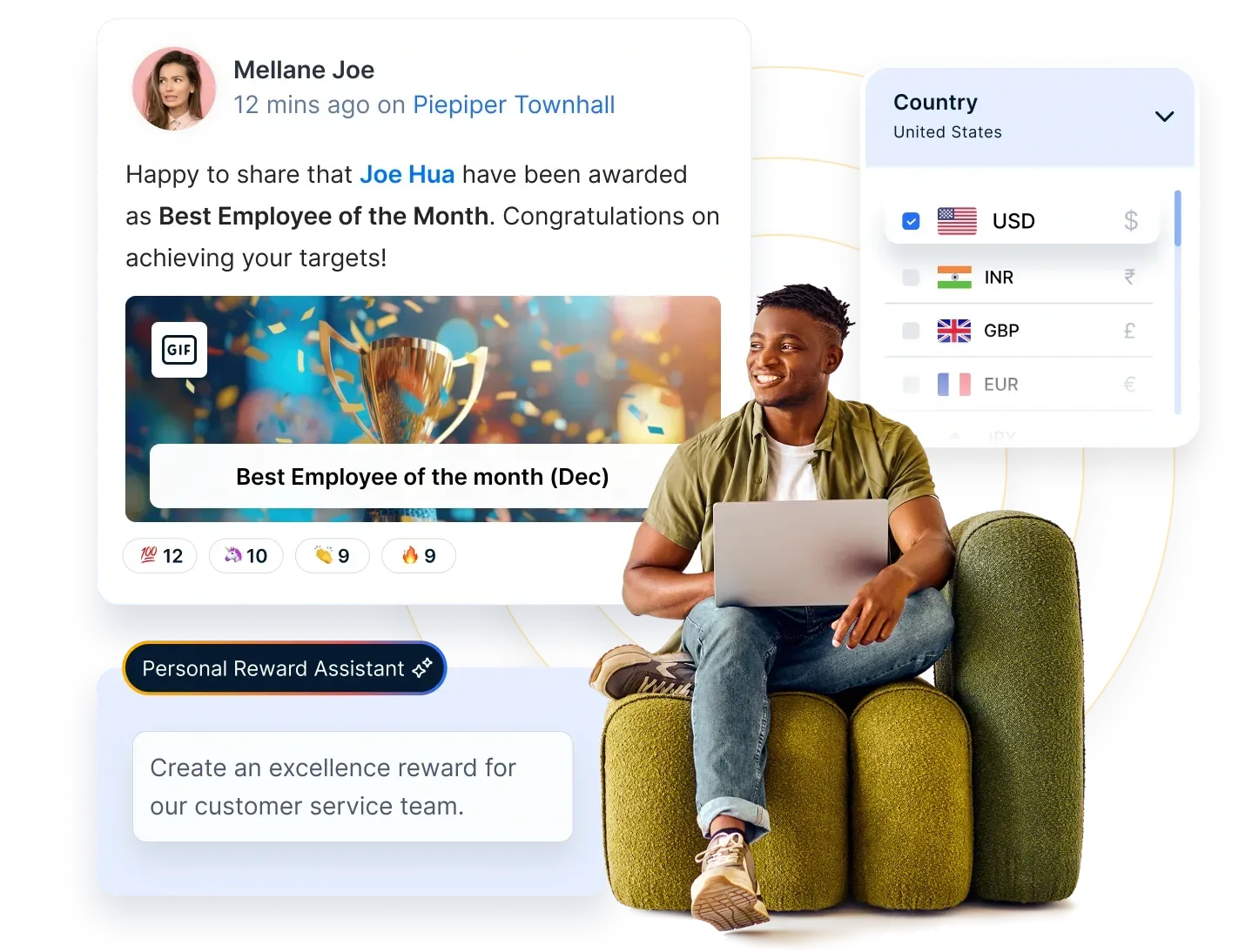Employee Motivation: What It Is, Why It Matters, and Theories to Know
Employee motivation is the driving force behind productivity and workplace success. Understanding the importance of employee motivation helps businesses create an environment where employees feel valued, engaged, and inspired to perform at their best.
On this page
Employee motivation is the level of energy, commitment, and creativity that a company's workers bring to their jobs. Highly motivated employees wake up excited to take on new challenges, eager to learn, and ready to push their limits.
And motivation isn’t just about enthusiasm—it plays a direct role in business success. The importance of employee motivation lies in its ability to drive productivity, improve retention, and create a positive work environment where employees feel engaged and valued.
This is why businesses invest time in understanding what motivates employees and how to sustain that motivation over time. Many assume financial incentives are the primary driver, but motivation goes far beyond just compensation.
Studies on employee motivation theories highlight that factors like career growth, recognition, and workplace culture are equally—if not more—important in keeping employees engaged.
Figuring out what truly drives employees may seem like a challenge, but when businesses focus on what works, they can enhance motivation levels, boost overall performance, and create a stronger, more committed workforce.
What is employee motivation: Meaning and definition
Employee motivation is the driving force behind an employee’s performance, creativity, and overall contribution to an organization. It’s not just about the paycheck; it’s about feeling valued, having a sense of purpose, and being part of something bigger.
When employees are motivated, they are more likely to go the extra mile, resulting in higher productivity and a positive workplace culture.
Technology has transformed every aspect of the workplace, including how we motivate employees. Today, businesses can leverage innovative tools to assess, monitor, and enhance employee motivation, creating a more dynamic and responsive work environment. These tools enable personalized motivation strategies that can cater to individual needs, making motivation more effective and sustainable.
6 Employee motivation theories in the workplace
There are various theories and research on employee motivation. We'll discuss some of the important employee motivational theories in the workplace to explain employee motivation.
1. Maslow’s hierarchy of needs theory of motivation
Psychologist Abraham Maslow came up with this theory in his famous 1943 paper ‘A Theory of Human Motivation'.

The basis of his theory is that human beings need to have their most basic needs met before they can get the motivation to achieve those higher goals.
His hierarchy has five levels:
- Physiological – these basic needs, like food, water, sleep, and shelter, have to be met in order for a person to survive.
- Safety – these needs help people feel safe and include health, freedom, and personal and financial security.
- Social – these needs are for connections like love, friendships, relationships, and family.
- Esteem – these needs are to feel good about yourself, confident, appreciated, and recognized.
- Self-actualization – the top of the pyramid is the need to become your very best self.
This theory makes sense - if you’re worried about where your next meal is coming from and how you’ll afford it, you’re not going to be able to do a lot of top-notch thinking about strategic initiatives.
What does this mean for employee motivation?
Supporting the needs of your employees outside of work is vital. They will not achieve everything they’d like to at work if they’re uncertain about their next paycheck or taken up with basic daily chores.
This is why many companies offer perks like on-site amenities, flexible work schedules, wellness discounts, and more.
Employees are not just workers - they’re human beings with complex needs and helping them fulfill more of those needs can allow them to shine when they’re at work and thrive outside of it too.
According to Maslow’s theory, in order to understand a person’s motivation at their work, an organization needs to understand the person’s general motivations first. An employee first looks forward to meeting his physiological needs of food, water, and shelter.
When this is met, he moves up the hierarchy to fulfill his safety needs, then to the next, and so on. The highest need in the hierarchy is self-actualization which encourages one to become the best version of themselves.
An employee works his/her way up this hierarchy and upon fulfilling any need level, aspires for the next one. So organizations should identify the position of each employee in the need hierarchy and motivate him/her to reach the next level.
The employee motivation as per this theory can depend upon the type of your industry, the size of the company, the current stage of the company. Eg. A company with largely white-collar employees have different motivational needs compared to a company that has largely blue-collar employees.
2. Hertzberg’s two-factor Theory
Developed by psychologist Frederick Herzberg in the 1950s, the two-factor theory posits that two main factors significantly influence employee engagement and motivation.
- Motivator factors are factors that provide employees with positive motivation to do their best at work every day. These positive factors include feeling recognized and appreciated, enjoying their role, and seeing a clear career progression path.
- Hygiene factors are the factors that can make employees feel dissatisfied and demotivated when they’re not present. These negative factors can include salaries, benefits, relationships with coworkers and managers, and company policies.
Both of these factors contribute significantly to employee motivation, but they operate independently of each other. You need to work on both factors to really improve employee motivation.
Preventing low motivation means taking care of those hygiene factors, so employees feel well-paid and happy with the people they work with. And raising motivation means promoting those motivator factors like making recognition frequently and meaningful.
3. Self-determination theory of motivation
External factors are certainly important for employee motivation - but it can also be highly helpful and effective to provide the framework for increasing internal motivation as well.
That’s where the Self-Determination Theory comes in.
This theory posits that satisfying the three basic psychological needs of employees helps encourage intrinsic motivation and high-quality performance.
These three basic internal needs are:
- Relatedness, or the feeling of being cared for and having a strong sense of belonging. This means making people feel heard, valued, and appreciated.
- Competence, or feeling effective and experiencing growth. Trusting employees to do their jobs well while holding them accountable for achievable goals is a key factor here.
- Autonomy, or empowering employees to feel like they’re in charge of their own actions, can make their own choices. Avoiding micro-managing and encouraging employees to take initiatives on their own help fill these needs.
This employee motivation theory is all about creating a workplace environment that helps employees be their best selves.
The human need to grow, feel valued, and have confidence in skills is at the heart of this SHRM-approved theory, especially in difficult external times.
4. Expectancy theory of motivation
Victor Vroom’s expectancy theory states that a person’s motivation depends on three factors: expectancy, instrumentality, and valence.
It differentiates between the efforts put by a person, his/her performance, and the final result. Victor Vroom argues that when employees have the liberty to make choices in their work, they mostly choose something which motivates them the most.
People choose how they’ll behave as per the outcome they expect from that behavior - that’s the logic behind the Expectancy Theory. That means, in short, we decide what we’re going to do based on the outcome we expect. Humans are generally pretty rational creatures, and Expectancy Theory agrees with that notion.
According to this theory,
Motivational Force = Expectancy x Instrumentality x Valence
- Expectancy: What employees expect from their own efforts.
- Instrumentality: It is about whether the employee’s performance is good enough to achieve the desired result.
- Valence: which is how much you value the expected reward.
To motivate an employee, there has to be a positive correlation between his effort and performance. An employee’s persona, his/her skills, and the expectations he/she has from his/her own abilities together form a motivating force for the employee. To keep up with and analyze the overall employee performance, consider using various employee time-tracking apps and task management tools.
In the expectancy theory of motivation, Victor Vroom suggests that organizations looking to motivate employees need to ensure that all three factors: Expectancy, Instrumentality, and Valence are positive or high.
All three factors need to be achieved for employee motivation. Even achieving two out of three factors does not motivate employees.
The expectancy theory also states that even if the employer has provided everything to motivate the employee, the employee still may not be completely motivated unless he/she believes that the employer has actually provided what is needed.
What does this all really mean? People are motivated to perform well if they believe there’s a reasonable chance, they’ll get a reward that they value.
So, if you’re trying to increase employee performance by handing out little ceramic sculptures of frogs as a reward for good work, employees might think they have a good chance of getting that reward - but it’s not really valuable.
On the other hand, if merit raises are highly valued but are rare and stingy at your company, employees will probably not be highly motivated since they don’t see a high likelihood of a decent raise coming soon. Instead, try to set goals for your employees to achieve and then provide rewards for those goals they actually want.
5. Three-dimensional theory of attribution
Human beings are always looking for meaning in everything that happens to us. This is the basis behind the Three-Dimensional Theory of Attribution, which was developed by Bernard Weiner.
It says that people try to determine why we do what we do, and the reasons we try to find in our behavior influence how we act in the future.
This theory boils down to three main characteristics we tend to attribute behaviors to.
- Do we see the problem as temporary, like a bad night’s sleep? Or is it an ongoing and stable issue, like our own unworthiness?
- Do we believe the problem was caused by external events, like the presentation computer crashing? Or do we locate the problem internally to a lack of our own intelligence?
- Were the factors for presenting well within our control or outside of it? Was it a lack of preparation we could have controlled or an internet outage that was outside our control?
When people feel they lack innate strengths and skills, they can tell defeatist stories about themselves that cause them to give up hope for improvement. And that’s a very demotivating feeling.
On the other hand, when employees feel they can control more factors that caused problems and know how to fix them, they’re more likely to make improvements and feel motivated to do better.
6. Nudge theory
Nudge theory credited to American academicians Richard H Thaler and Cass R Sunstein motivates employees to make decisions that are in their broad self-interest.
Organizations can gauge how each of their employees thinks and make it easier for them to choose what is best for them, their families, and society.
Nudge theory can also be used to explore and understand influences on how people behave, especially looking at negative influences, with a view to getting rid of them. This theory clearly accepts that people have certain attitudes and capabilities and considers it a part of human tendencies.
Organizations cannot force employees to adopt a particular behavior or follow a set of rules. They can only change the employees’ behavior towards a certain something without forcing it on them.
They can simply nudge or influence them toward the right set of decisions. One way of doing this is to give references from other people’s behavior to highlight what is acceptable and desirable.
What is the importance of employee motivation in an organization?
Employee motivation is the energy, commitment, and enthusiasm employees bring to work. Motivated employees enjoy their jobs, strive to do their best, and seek growth beyond just a paycheck. While no one stays motivated every day, engaged employees bring enthusiasm most of the time.
However, many businesses struggle with keeping employees motivated. It requires thoughtful effort to maintain engagement throughout a career. Motivated employees not only excel in their roles but also inspire those around them. When in leadership positions, they drive teams toward success with focus and positive energy.
On the other hand, unmotivated employees often feel bored, dissatisfied, or burnt out. Managers play a key role in fostering motivation, making leadership essential in building an engaged and productive workforce.
According to Gallup, only two out of ten employees strongly agree their performance is managed in a way that motivates them to do outstanding work.
That’s a significant motivation gap. And since there are so many benefits to having highly motivated employees, that gap is a big miss.

Keep Your Employees Motivated & Engaged
A paycheck isn’t enough employees thrive on recognition, meaningful rewards, and a sense of belonging. With Empuls, celebrate achievements and boost motivation effortlessly.
Benefits of motivated employees in the workplace
How do companies benefit from having plenty of motivated employees? Here are the seven important benefits of motivated employees in the workplace:
1. More innovation
Employees who genuinely enjoy their jobs and feel motivated to do their best are also motivated to frequently develop new improvements and ideas.
Motivated employees, unburdened by self-limiting beliefs, have the energy and enthusiasm to be real innovators on their teams and the company.
They will see possible areas for improvement and be willing to make things happen, and your business will be highly innovative as a result.
2. High employee engagement
Working with a whole group of demotivated employees can drag down even a highly engaged employee.
But on the other hand, joining a team of motivated employees can help increase overall engagement rates and help employees have more commitment to their workplace and work.
And since engaged employees are such an asset to your business, raising overall engagement rates has many benefits. Motivation and engagement tend to go hand-in-hand.
3. More efficient employees
Employees who get more done in less time are very valuable. They can accomplish a lot in the same amount of time compared to other employees. And if their work is very high-quality, you can see big productivity gains with a motivated team of employees.
Motivated employees are efficient because they are excited to get their tasks done and do a great job.
4. Lower levels of turnover
Employees who aren’t motivated or engaged at work have higher turnover rates - especially when it comes to your top performers.
On the other hand, motivated employees see the impact their work makes for their team or their company and feel inspired to stay and continue contributing at a high level. Keeping these highly productive and energetic employees is great for your business.
5. Increases job satisfaction
Job satisfaction determines an employee’s performance to a great extent. Higher job satisfaction would also mean a lower attrition rate in an organization. Getting a handsome salary is one thing but today’s employees look for satisfaction in their careers.
Employees who feel their voice is heard are 4.6 times more empowered to perform their best work. (Source: SalesForce)
6. Boosting employee morale
Motivation and morale go hand in hand, and morale is an indicator of how happy the employees of an organization are.
Encouraging the employees to make decisions at work, making their job more meaningful, giving employees a sense of responsibility and authority, and promoting creativity are ways to boost motivation and morale.
7. Self-discipline
Motivation promotes self-discipline among employees. Self-discipline helps employees accomplish much more than the discipline imposed by their seniors.
Motivated employee disciplines themself and believes that it is necessary for their interests.
Implications of employee motivation from the purview of organizational behavior sciences
Studying employee motivation from the purview of organizational behavior sciences helps Human Resource practitioners closer to achieving motivation at their workplaces. Occupational research breaks it down to help us understand the antecedents of employee motivation in isolation.
A better understanding of the benefits of employee motivation gives way to better achievements. Let us look at what the researchers have to tell about the benefits of motivated employees.
Innumerous studies have been conducted to understand what motivates employees and the following are the most important factors that decide the employee’s motivation.
1. Employee involvement: A feeling of being involved
Employee involvement or Employee participation is said to have the maximum on the employee’s motivation. Employee involvement can be created in an organization by creating an environment where employees can influence the decisions and actions that affect their jobs. This is more of a management and leadership philosophy than a strategy and it enables people to continuously contribute to the success of the organization.

Disengaged employees cost U.S. companies up to $550 billion a year - The Engagement Institute—a joint study by The Conference Board, Sirota-Mercer, Deloitte, ROI, The Culture Works and Consulting LLP
Following are a few ways employee participation can be improved:
0️⃣ Job security
A guarantee of regular income is the primary motivation for employment and job security is the measure of this assurance. Job security refers to the probability of losing or keeping one’s job and a great influence on the motivation levels of an employee.
89% of workers at companies with well-being initiatives would recommend their company as a good place to work- American Psychological Association
There are several factors that affect the perceived job security of the employee and the following are the most important of them:
1️⃣ Trust
The amount of trust the employees have on the organization and their manager affect the amount of perceived Job security because trust is defined as the expectancy of banking upon something. This trust can either be relational - based on the personal connection the manager and the subordinate has - or it can be calculated - based on the abilities of the manager or the subordinate.
People at high-trust companies experience 74% less stress. - Harvard Busines Review
2️⃣Self-efficacy
Self-efficacy is the way an employee judges hi/her own performance at their job roles. This perceived performability of the employee in his/her role plays an important role in job security because the probability of retaining somebody on a job increases with their performance.
3️⃣Task-oriented leadership
Task-oriented leadership or goal-focused management refers to when a leader encourages task completion, increases goal clarity, constantly improves communication efficiencies, and regulates unproductive behaviors of the employees.
Almost $7 trillion are lost in the name of unproductive employees - Gallup
When employees have precise instructions on tasks and know exactly what to do, it will lead to tasks getting completed. Task-oriented leaders are thus perceived to provide better job security because this increased probability of task completion leads to safer employment.
4️⃣ Organizational Identification
Organizational identification happens when the employees identify with the organization, owning up the organization’s successes and failures are their own. Employees with higher organizational identification tend to feel better job security because they tend to take the responsibility of instilling job security as their own.
5️⃣ Supervisor’s help with personal problems
The ability of the supervisor to empathize and help in solving the employee’s personal problems affect employee motivation. An external determinant of employee motivation and productivity loss is their personal problems.
19% of employees view their bosses as mentors, people they can learn from and trust - Monster
When the supervisor genuinely tries to connect with the employees, in an attempt to attend to and accommodate these problems, employees are partially relieved of the tension of their out-of-work issues. This reduction in stress and anxiety will lead to reinstating the employee’s motivation.
6️⃣ Good Wages
Nominal wages for work is a physiological need for an employee. It is with these wages that all his/her basic necessities can be fulfilled. Wages can also be classified as a hygiene factor, a lack of which can cause extreme dissatisfaction. The most interesting observation around wages is that employee motivation is not directly proportional to the wage increase. In fact, there were studies that showed similar employee motivation scores across wage brackets.
7️⃣ Interesting work
Job enrichment is a way to make work interesting and challenging, which will lead to improving skill sets and motivation levels. This can be achieved through:
- Ensuring that an individual's goals and how these fit into the overall corporate mission of the company are thoroughly understood by the employees.
- Providing resources such as IT, communication tools, and training for each employee to perform well.
- Creating peer support networks and supportive management - so as to ensure an environment of conduciveness.
- Creating transparency and free flow of information across the organization.
- Providing autonomy and rewarding employee initiatives.
- Providing adequate rewards and recognition.
- Providing opportunities for skill improvement, like fully paid training less and admission to conferences.
- Provide job variety through job sharing and job rotation programs.
8️⃣Tactful discipline
To tactfully discipline employees is an important factor of motivation. This can be done by:
- Providing clear guidelines for work.
- Planning and projecting key result areas with utmost accuracy.
- Keeping conversations open and aim at finding the root causes of the problem.
- Being careful of giving negative feedback - be extremely conscious of not making the process more personal in any way.
- Always giving negative feedback in private.
- Maintaining complete confidentiality regarding the issue and work with the employee to resolve it.
- Constantly reassure confidence in the employee.
- Providing multiple rounds of instructions and constructive feedback, until the issue is resolved.
9️⃣ Promotion or career development
The opportunities for promotion and career development highly affects the motivation levels of the employees. These career advancement opportunities can be an increase in salary or widening of the scope of authority, job duties, and responsibilities. It can even be a change in location or territory. These changes can be made based on proficiency, work experience, or training.
🔟 Good working conditions
Working conditions of an organization can affect the health and safety, security, and working hours of an employee.
61% of employees are burned out on the job - CareerBuilder
Employers have a general duty to ensure that the working conditions are as per statutory mandates. This includes managing the maintenance, ventilation, temperature, ambiance, workstations, facilities, and interiors of the office so as to ensure a congenial working environment. This also includes proper communication and online safety training for precautions and usage of work tools.
2. Increased employee productivity
Several studies have proven a strong correlation between employee motivation and performance. In fact, one of the most important benefits of motivated employees is the amount of productivity enhancement it brings.
The effects of motivation on employee productivity not only are the actual quantitative and qualitative outcomes of their tasks significantly better, but the employees also themselves perceive their performances as good. This positive perception and conviction allow them to increasingly improve their performances further.
45% of employees complain that outdated versions of software keep them from being productive - Unisys
3. Employee satisfaction
Motivated employees tend to believe that their organizations allow them to grow as an individual and enable them to effectively contribute to the organization - thus driving the effectiveness of employee initiatives.
They also tend to positively perceive the organization’s environment to be cooperative, fair, and trustworthy. They feel that the organization is genuinely interested in their wellbeing and resultantly score high on employee satisfaction scores and promoter scores.
81% of employers that offer benefits agree that their company’s benefits offerings increase employee satisfaction - Aflac
4. Improved employee organizational citizenship behavior
The increased employee satisfaction enables the employees to empathize with organizational goals, ethics, and moral values. This results in employees exhibiting behaviors that account for organizational citizenship behavior.
These are characterized as actions and behaviors that go beyond their normal job responsibilities but benefit the team and organizational functioning and efficiency.
Drive employee motivation with Empuls

Keeping employees motivated goes beyond paychecks—it’s about recognition, engagement, and a strong sense of belonging. Empuls makes this easy with a comprehensive platform for rewards, recognition, engagement tracking, and workplace culture enhancement.
- Recognize & reward achievements: Celebrate milestones, performance, and contributions with real-time recognition and meaningful rewards.
- Measure motivation & engagement: Use AI-driven surveys to track engagement and gain insights into employee sentiment.
- Enhance workplace culture: Foster collaboration and connection with social intranet and culture-building tools.
- Offer meaningful perks: Boost satisfaction with fringe benefits that employees truly value.
With Empuls, businesses can create a motivated workforce that feels valued, connected, and driven to succeed. Ready to build a culture of motivation? Get started with Empuls today!
Conclusion
The importance of employee motivation lies in its impact on productivity, job satisfaction, and business success. A motivated workforce drives innovation and retention, but it’s up to organizations to create an environment that fosters engagement and growth.
For decades, employee motivation theories like the Maslow’s hierarchy of needs, Hertzberg’s two-factor theory, and Expectancy theory of motivation have helped businesses understand what drives employees. Using these insights, companies can implement strategies that keep their workforce engaged.
To simplify motivation, engagement tracking, and rewards, Empuls offers an all-in-one solution.
Boost employee motivation with Empuls. Get started today!















